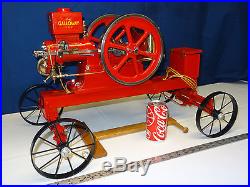
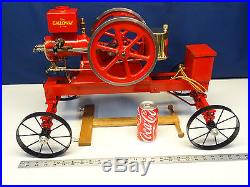
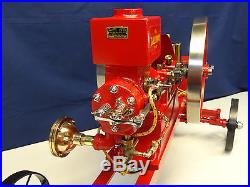
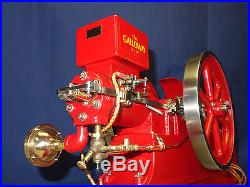
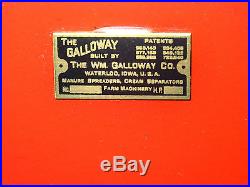
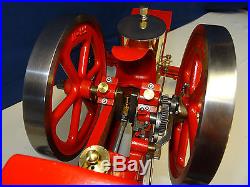

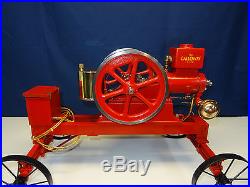
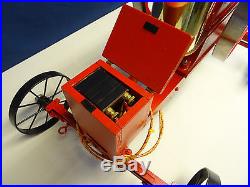

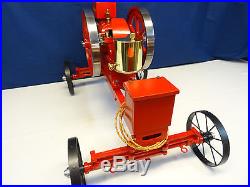
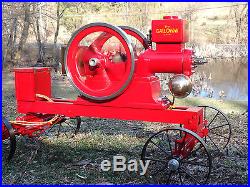
1/4 Scale Running Model Reproduction of a 5 H. Galloway Antique Hit and Miss Engine. It’s a NICE one! This one has 8 inch flywheels and from what I know, it is ¼ scale. I have another Galloway that has 10 inch flywheels and that one should be a 1/3. Here are the details on this engine. These are the measurements of the engine only, as if it was not mounted on the cart. It has 8 flywheels. In the posted video I made a mistake and said the flywheels were 7 ½ inches. They are actually 8 inches. It’s 16 inches long from the rocker arm to the back of the fuel tank. The widest part is the end of the crankshaft that sticks out from the flywheels, that makes it 8 ¼ inches wide and it’s 9 ½ inches tall. Measurements of it on the included cart are 25 ½ inches long from the front of the front wheel to the back of the rear cart wheel. The cart is 16 wide to the outside of the cart axles and it stands 16 inches tall from the ground to the top of the water hopper. The cart wheels measure 5 ½ inches. It weighs about 41 pounds. This engine gets its spark from a low tension coil that is mounted in the wooden box on the rear of the cart. It has a scale make brake ignition system that will run on 6 or 12 volts. The wire for powering the ignition system is coiled up around the coil box. A battery is not included. There are more details on the running of this engine listed below. Also a link is is posted that will take you to the video of this engine running. I ran this engine before doing the detail work of cleaning and polishing. So the posted photos were just taken and this is the way you will be receiving it. Many hours of machine work, paint work, polishing, assembly, adjusting and testing goes into producing a high quality scale model like this. A lathe, milling machine, drill press, lots of tools and an experienced operator(s) were needed to finish the rough castings and to fabricate the additional parts required. Having to pay someone for all of the machine work and fabrication involved would cost quite a bit! Whats included in this sale: You get the ¼ scale Galloway as pictured mounted on the all metal scale cart that has metal wheels with spokes. The front axle is fixed to the frame and the rear axle steers the cart. There is a scale wooden moving handle that attaches to the rear steerable axle. It is shown in a couple of the photos. Here is a web link that will take you to the video of this engine running. In this video I said the flywheels are 7 ½ inches. I was not correct as they are 8 inches. Take note in the video about how slow I had this engine running and it did not skip a beat. Most videos of scale engines like this show them running at a much faster speed and they still miss every now and then. I think that running them fast does not them a scale appearance. I first tried starting this engine on some old (had already been opened a few years back) Coleman lantern fuel. It ran but not that smoothly. It then fired right up and ran as you see it in the video. On the fuel mixture, it ran best between ¼ and ½ turn out at the most. Anything over a half a turn and it ran rich. The battery I used is a old 12 volt jell cell type battery that showed about 10 volt when I tested it. The included low tension coil should work on 6 or 12 volts, though I did not have a 6 volt battery to try it. On setting the speed. The governor setting can not be changed while the engine is running as it is mounted on the inside of the left flywheel. My reference for what is left and right would be if you were behind the fuel tank looking towards the front of the engine. Inside of the left flywheel you will see a threaded rod with the adjuster nut on the one end and the governor spring on the other. When turning the nut in, on to the threaded shaft, that increases the spring tension and the engine will run faster. In the video I had the nut all the way out to the end of the threaded rod. On the engine rotation direction. When looking at the side where the left flywheel is mounted. (the push-rod and the ignition are all on the left side) The flywheel rotates clock-wise. I used 10-30 wt. Oil in the drip oilier. Turn the top out about a turn and a half so it forms a drip every once and a while. The crankshaft end caps have grease cups on them. Tighten the top part and it forces grease down in the bearing area. There is a clear synthetic grease in them right now. There is a oil cup on the big rod end. Get some oil up on the wrist pin of the piston. If a part moves against something, oil it! That included the valve stems and the small valve stem that is on the bottom of the fuel mixer. Yes it will get dirty and drip oil when running it, just like the full scale engines do. The photos for this ad were taken after it was run for the video. NOTE: The rocker arm for the exhaust valve is held in place with two pins. One in the center and one on the push-rod end. These two pins are both the same size and they are just pushed in place. If the engine was turned upside-down they could slide out. They have a cotter pin holding on a aluminum spacer on the outside then there is the wheel. The cart wheels are the same on the inside and outside so it does not matter what way they are put back on. I check my emails often and will respond in a timely manor. All sales are final as I will not accept a return on a item like this. NOTE: This is a running reproduction of a antique engine. It is a adult collectible item and is intended to be used by a experienced adult. Just like the original engine, it has no safety guards in place. Loose clothing, long hair or fingers could become caught in any moving part when this engine is running or even being turned over by hand. Use commonsense and keep your fingers especially small fingers! Away from all moving parts! I make no guarantees or clams as to how it will run for you or even if you would be able to get it started. Some mechanical knowledge and experience is needed to run any antique model engine like this. I have clear photos posted of this engine and I have a video posted showing it running. You should have some knowledge of a engine like this, like how to maintain it, keep it lubricated and adjust it if necessary as I provide no instructions other than what is in my videos and written in this ad. No guarantees of any kind are included with a custom hand made, one of a kind adult hobby item like this. This item was listed on Wednesday 3-16-17 and is not pre packaged in advance right now. So should I get a question on the engine where I need to see something or send a photo I can easily do that. Once it’s packed, I wont be able to do that. Should there be any questions, PLEASE ask! This is Naptha (a type of gas) powered scale model engine that comes with no instructions or guarantees what so ever!! Do not stick your finger or other body parts in a rotating mechanical assembly!! The new owner assumes all responsibilities and liabilities to himself/herself and others with this engine. This is an adult collectible item not to be operated or played with by children. I make no clams to it being safe as it is a antique scale model reproduction produced back in the day when no safety guards, air bags, safety warning labels, ect.. Were attached to dangerous products. I make no claims that it will even run as some might not have the mechanical ability to figure it out. By purchasing this item you are stating that you have read my whole ad, you understand it and that you agree with the terms and policy’s stated in this ad. I have detailed photos posted. A link is in this ad that shows this engine running. Thank you for looking!! Should you have any questions, please ask. Thank you for looking! The item “1/4 scale Galloway Hit and Miss gas powered model engine, Video of Running” is in sale since Wednesday, March 15, 2017. This item is in the category “Business & Industrial\Light Equipment & Tools\Stationary Engines\Engines”. The seller is “t-n-b123″ and is located in Reading, Pennsylvania. This item can be shipped to United States.
- Brand: Domestic
- Powered By: Naptha/Coleman lantern fuel
- Country/Region of Manufacture: United States
- Model: Hit and Miss